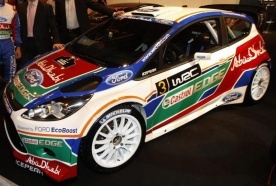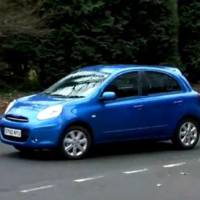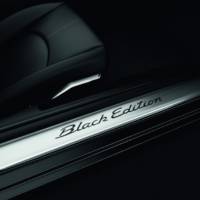The Blue Oval has released the 2011 Ford Fiesta WRC specs, as the new Rally Championship challenger is awaiting for its final clearance to compete in the Rally Sweden next month.
The 2011 Ford Fiesta WRC which was developed by M-Sport from the 2010 Monte Carlo Rally-winning Fiesta S2000 rally car, is fitted with a 1.6-litre EcoBoost 4-cylinder engine turbocharged by a Garrett system and packs 300 HP and 331 lb-ft of torque.
Power is sent to all four wheels through the M-Sport / X-Trac-built 6-speed sequential gearbox, plus the 2011 Ford Fiesta WRC contains mechanical front and rear differentials, and a clutch disconnected system fitted to the handbrake.
The front and rear suspension of the 2011 Ford Fiesta WRC comprises of MacPherson struts with external reservoir dampers, while its brakes are represented by Brembo ventilated discs with 4-piston monoblock calipers.
The 2011 Ford Fiesta WRC also uses 650 mm tires wrapped around 7 x
15 inch aluminium wheels for gravel and snow, or 8 x 18 inch wheels for asphalt.
Ford press release :
COLOGNE, 31 January 2011 – Ford’s all-new Fiesta RS World Rally Car is set to receive final clearance for its FIA World Rally Championship debut this week when motorsport’s governing body gives it the seal of approval to compete in Rally Sweden next month.
The Fédération Internationale de l’Automobile (FIA) is ready to approve homologation of Ford’s challenger for the 2011 championship after the car successfully cleared tough technical inspections to ensure it complies with the sport’s new cost-effective regulations.
This means that Ford Abu Dhabi World Rally Team drivers Mikko Hirvonen and Jarmo Lehtinen and team-mates Jari-Matti Latvala and Miikka Anttila will put the Fiesta RS WRC through its paces for the first time in the WRC when the 13-round season begins in Sweden (10 February).
"We worked closely with the FIA throughout the development of the car to ensure our understanding of the regulations was aligned with that of the governing body," said Ford of Europe’s motorsport chief, Gerard Quinn. "We expect the paperwork to be finalised this week, and everyone involved with the programme is looking forward to an exciting season ahead, with the action beginning over Sweden’s frozen roads in 10 days."
Ford’s road technology powers Fiesta RS WRC
Ford’s four-wheel drive WRC challenger is derived from the best-selling Fiesta road car. It was developed from the 2010 Monte Carlo Rally-winning Fiesta S2000 rally car by the Blue Oval’s long-term British-based partner M-Sport, with support from Ford of Europe. It forms part of a new era in the World Rally Championship, for which a revised cost-effective formula is introduced this season.
The WRC is acknowledged as the toughest form of motorsport for production-based cars, which battle for world titles in such diverse and demanding conditions as the barren, frozen countryside of Sweden and sweltering temperatures and boulder-strewn roads of Greece.
M-Sport, together with Ford’s engineering team, undertook a varied and structured development programme with the Fiesta RS WRC in readiness for the 2011 season. Work will continue, with the car shortly due to be taken to the Environmental Testing Laboratory at Ford’s Dunton Technical Centre in the UK to evaluate and optimise engine performance.
Ford Abu Dhabi technical director Christian Loriaux said the team had not compromised on anything. "We obtained plenty of data from the standard Fiesta road car, and the S2000 which competed in the S-WRC and other championships last year. We re-evaluated every area and if we thought certain areas could be improved, we went ahead and did so," he said.
"Apart from the roll cage and chassis there aren’t too many parts that the Fiesta RS WRC shares with the S2000. Plenty of parts may look similar, but they have been modified to be lighter, stiffer or whatever we felt would bring an improvement," added Loriaux.
Ford of Europe’s design team played a key role in the look of the Fiesta RS WRC. Its input ensured that the car visually reflects the successful ‘kinetic design’ styling cues synonymous with Ford’s line-up on the road.
"Together with Ford of Europe’s design team, we carried out a full restyling of the car to incorporate as many aspects as we could of Ford’s kinetic design styling cues that are an integral part of the company’s road vehicles. There are some necessary modifications for aerodynamic reasons, but both Ford and M-Sport are delighted with the car’s appearance," said Loriaux.
1.6-litre Ford EcoBoost technology
The 1.6-litre turbocharged direct injection engine that powers the rally car draws on the knowledge of Ford’s advanced EcoBoost technology, used in its latest production cars.
Quinn said: "Ford’s EcoBoost road engine represents a new generation of downsized, high-efficiency, petrol engines. Developed by Ford engineers in Europe, the four-cylinder EcoBoost production unit combines high-pressure direct injection, advanced turbocharging and twin variable valve timing to maximise combustion efficiency. Different displacements are already available in Ford road vehicles around the globe.
"The knowledge accumulated during the design of the EcoBoost road engine proved invaluable during development of the rally car unit. Technology transfer usually switches from rally cars to road vehicles, but in this situation we’re delighted it has taken the opposite route," he added.
Engine tuner Pipo Moteurs took responsibility for the development of the Fiesta RS WRC’s power plant. The French company, which has developed a strong relationship with
M-Sport and Ford in motorsport in recent years, worked closely with engineers from both companies throughout the process of developing the competition unit.
Ford provided key support in this task via its global engineering facilities, including its Powertrain Research and Innovation Centre in the United States, its Engine Research Centre at Dunton in the UK and its Research & Advanced Engineering Centre in Aachen, Germany, to evaluate performance.
The most challenging task was to implement direct injection technology, which is relatively new in motorsport, and Loriaux admitted the engine development was a huge task. "It was a massive undertaking. Direct injection was a complex beast and it was the first time many of us in the team had the opportunity to work with forced injection in a competition engine. The engine was the biggest challenge of the whole project," he said.
Under the skin of the Fiesta RS WRC
The Fiesta RS WRC’s 1.6-litre EcoBoost power unit has turbocharging from a Garrett system, which is fitted with a 33mm inlet restrictor, as required by FIA regulations. The unit is managed by Cosworth’s electronic engine system. Cosworth also provides chassis data acquisition.
The four-wheel drive transmission contains mechanical front and rear differentials, with a clutch disconnect system fitted to the handbrake. The M-Sport / X-Trac-built six-speed sequential gearbox is operated by a mechanical shift, using a twin disc clutch built by
M-Sport and AP Racing.
Both front and rear suspension comprises MacPherson struts with Reiger external reservoir dampers, which are adjustable in bump and rebound. It contains fully adjustable steel links and the uprights are made from machined aluminium.
Brembo ventilated brake discs with four-piston monoblock calipers provide the stopping power on both loose and sealed surface roads, with the braking system adjustable to provide either front or rear bias.
Michelin’s 650mm tyres will be used on all surfaces, allied with 7in x 15in aluminium wheels for gravel and snow and 8in x 18in wheels for asphalt.
Fiesta RS WRC racks up testing kilometres
The Fiesta RS WRC has covered more than 11,000 kilometres of testing on gravel, asphalt, snow and ice in preparation for its WRC debut – the equivalent of more than two full seasons of WRC competition.
The team began by installing a 2.0-litre engine from a 2010 Focus RS WRC into the Fiesta S2000 rally car in March last year.
Testing was stepped up significantly in August when a 1.6-litre prototype engine (without direct injection) was installed for the first time. Since then the car has been trialled on gravel roads in Britain, Portugal, France and Spain and on asphalt in Britain, France and Spain. Snow and ice tests have taken place in Sweden.
"We’re encouraged by both the car’s performance and its reliability over thousands of kilometres of testing, and we’re confident we can transfer that into competition. But the true test will come during the opening round in Sweden next week," said Ford Abu Dhabi team director Malcolm Wilson.
"It was a challenging test programme. Matching the car to the tyres of our new supplier, Michelin, was a demanding process. We’ve made excellent progress but I believe Mikko and Jari-Matti will learn more about the way the tyres behave as we encounter new conditions on different rallies," added Wilson.

01 Feb 2011
0


